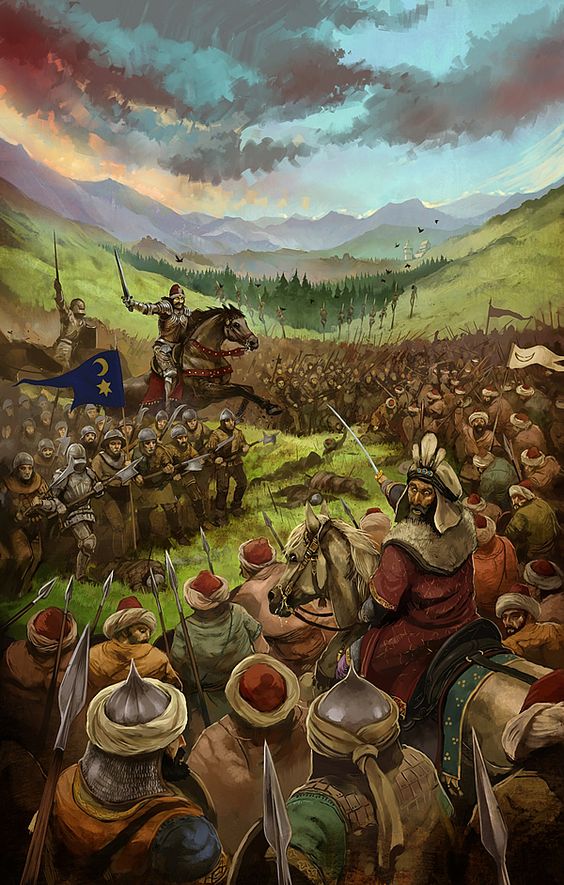Vlad the Impaler was a medieval Romanian prince famed for his brutal torture techniques and vicious lust for battle. His family name was Draculea, meaning ‘son of the dragon’. In legend, he is said to have turned against God after the death of his wife, becoming the evil undead. This myth lead to the modern interpretation of Count Dracula and other Vampire stories. In reality, Vlad was not a count but a prince. Whilst he was born in Transylvania, Vlad was Crown Prince of Wallachia, a country in the south of present day Romania, bordering Transylvania. He frequently made attacks on Transylvania, which was a contested region, and slaughtered many there for not accepting his authority.
Whilst Dracula is commonly associated with evil he is sometimes seen as being somewhat of a Christian hero. He was a member of the ‘order of the dragon’, an order of Hungarian knights sworn to protect Christian lands from the Muslim Ottoman Empire. Located between Christian Hungary and the huge Ottoman Empire, Wallachia was on the front line in the Ottoman expansion into Europe. Vlad’s barbarous torture techniques have earned him a place in history but they were not altogether unusual in medieval Europe. They may also have been exaggerated by his enemies. Impalement was supposedly his preferred method of execution, but this was common practice at the time. Reports that he burned entire villages to the ground are also unsurprising. In Western Europe, however, tales of Vlad’s attacks across the Balkans led to him being branded a ‘bloodthirsty’ tyrant. In Russia, on the other hand, stories of his brutality were equally rife, but most portrayed him as being a strong ruler and justified in his actions. These Russian accounts tell that he nailed hats to ambassadors’ heads.
The idea that Dracula was immortal may be derived from his own propaganda or that of the Ottomans, who found it difficult to put an end to his insurgency. When he finally was killed in battle, the Ottomans removed his head and placed it on display as proof of his death. It was impaled on a spike in a final twist of irony.
Stephen the Great and Vlad Tepesh.
Military
The military of Wallachia was called the Host [Oastea]. When fully mobilized, the Wallachian army could number 30-40,000 warriors. The ruler of Wallachia was the grand general of the army, called “Mare Voievod”/”Grea Warlord.” The army was divided into two groups, the Oastea Mica [Small Host] and the Oastea Mare [Large Host].
The small host was a semi-permanent, rapid-response force composed primarily of cavalry. It comprised of the Voievod and his guard, the voievod’s Curteni [“men of the court”] and slujitori [“servants”] as well as the boieri nobles and their retinues. Towns which were direct property of the voievod took part in the Oastea Mica, but recieved economic benefits for this. Each boier was assigned as the commander of the troops he brought, organized under their “flags.” In times of crisis, the system of “flags” was symbolic and the entire army was temporarily placed under the command of the voievod. To this was also attached any specialized divisions of infantry, mercenaries, and border guards [plaiesi]. The fact that this part was mostly cavalry allowed the Wallachians to respond quickly to Ottoman or Tatar raids. Long campaigns outside of Wallachia’s borders were almost exclusively only done with this force.
The second part of the army, called the Oastea Mare [“Great Host”] was composed of a general levy throughout the country and comprised mostly of infantry. This was composed of troops taken from cities [targoveti], free peasants [mosneni] which were levied, and rarely, serfs [vecini]. The right to call the Oastea Mare and to grant towns leave from this was only held by the voievod, and the boieri were completely excluded from the act of levying this force. In cities the troops for the Oastea Mare were organized under the leadership of the city’s head, a jude. The jude was the voievod’s representative and thus still kept the force directly under the voievod’s command. This in some sense kept Wallachia’s army from being feudal in nature, as the vast majority of it was always under the voievod’s command. This army was only called in times of dire emergencies, like a major Turkish assault, and the best exhibited use was by Vlad Tepes, who raised 25,000 troops to fight off Mehmed II. The Oaste Mare was a potent defensive force but had no logistical preparation for long campaigns, with soldiers needing to feed off the land as they marched.
Alongside the army was added a system of defense of border fortresses. All of these were at the borders of Wallachia, with the most powerful being on the Danube (Turnu Severin, Giurgiu, Turnu, Braila) but some to guard the mountain passes as well (like Poenari). Of these the most powerful was Giurgiu, which after it was occupied by the Ottomans in the 15th century, posed a continuous danger for Wallachia.
Most of the military equipment was made in the towns and villages of the country, as well as some in the cities, but there are also reports of purchases of swords and gunpowder weapons from Transylvania, as well as armors from Italy. The earliest recording of the use of gunpowder weapons is in 1445 referring to two bombards placed on Giurgiu to defend it from the Turks. The use of cannons and firearms was noticeable but still very low in number, with muskets being used in far greater numbers in Moldavia.
